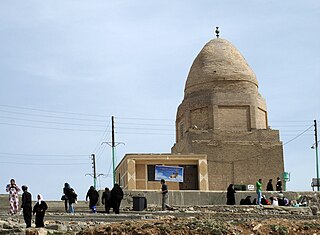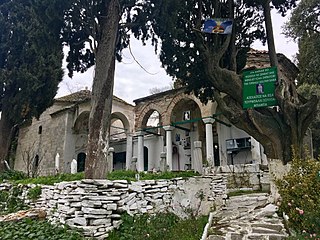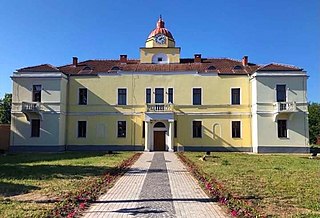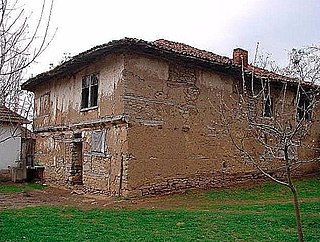Teke or Tekke can refer to:

Türbe refers to a Muslim mausoleum, tomb or grave often in the Turkish-speaking areas and for the mausolea of Ottoman sultans, nobles and notables. A typical türbe is located in the grounds of a mosque or complex, often endowed by the deceased. However, some are more closely integrated into surrounding buildings.

Vushtrri is a city and municipality located in the Mitrovica District in Kosovo. According to the 2011 census, the town of Vushtrri has 26,964 inhabitants, while the municipality has 69,870 inhabitants. Vushtrri is surrounded by the city of Mitrovica to the north, Podujevo in the east, Obiliq in the south, Drenas in the south-west, and Skenderaj in the west. The municipality of Vushtrri has 67 villages.

Hala Sultan Tekke is a mosque and takya on the west bank of Larnaca Salt Lake, in Larnaca, Cyprus. Umm Haram, known as Hala Sultan in Turkish tradition, was the wife of Ubada bin al-Samit, a companion of the Islamic prophet Muhammad, and foster sister of Muhammad's mother, Amina.

The Tekke of Dollmë or Haxhi Mustafa Baba Tekke is a Cultural Monument of Albania, located in Lagjja Kala, Krujë. Before its destruction by the Communist dictatorship, the tekke of Krujë had 360 holy graves and was known as "Little Khorasan".

The Tomb of Wais-e Nāzār is a historical mausoleum in Kermanshah, Iran. It is located on the top of a hill, 35 kilometres from the city of Ravansar. The deceased person entombed in the mausoleum is traditionally attributed to be Owais al-Qarani, one of the Tabi'een who died in the Battle of Siffin. It is number 1054 on the list of national monuments of Iran.

The Tomb of Bibi Jawindi is one of the five monuments in Uch Sharif, Punjab, Pakistan, that are on the tentative list of the UNESCO World Heritage Sites. Dating back to the 15th century, the shrine was built in the spirit of the historical Sufi premier Bibi Jawindi of the Suhrawardiyyah order, a strictly hegemonistic Sunni school of theosophical thought which puts particular emphasis on the Shafi’i school of classical jurisprudence in the context of its interpretation of the Sharia. Jaw Indo was great-granddaughter to Jahaniyan Jahangasht, a famous Sufi saint in his own right.
Monuments of Kosovo comprise all the monuments that are located in Kosovo.

Islamic monuments in Kosovo are commonly related with the Ottoman arrival in 1389, and respectively with their effective establishment in Kosovo in 1459. However, many historical evidences show that the first encounters of Islam with the Balkans happened well before the arrival of the Ottomans and their establishment in the Balkans. Because of its proximity to the centers of Islam, i.e., Middle East, the Byzantine Empire and parts of the Balkans, including the Albanian territories and Kosovo as well, were exposed to Islam as early as in the 8th century.

The Kosovan city of Gjakova has been populated since the prehistoric era. During the medieval period, in 1485, Gjakova is mentioned as a village, concretely as a market place.
Gjakova served as a trading center on the route between Shkodër and Istanbul.

Shrine of Jalaluddin Bukhari is the shrine of Jalaluddin Surkh-Posh Bukhari. It is located in Uch Sharif in present-day Punjab, Pakistan. It is one of the five monuments in Uch, Pakistan which are on the tentative list of the UNESCO World Heritage Sites.

Baba Shemimi, also known as Kemaledin Shemimi Ibrahim, Baba Shemim, Baba Shemimi of Fushë-Krujë or Baba Shemimi of Krujë, was an Albanian Bektashi bejtexhi and martyr.

The architectural heritage of the Kosovo Albanians during Yugoslav rule was shown institutionalised disregard for decades prior to outright conflict at the end of the 20th century. Numerous Albanian cultural sites in Kosovo were destroyed during the period of Yugoslav rule and especially the Kosovo conflict (1998-1999) which constituted a war crime violating the Hague and Geneva Conventions. In all, 225 out of 600 mosques in Kosovo were damaged, vandalised, or destroyed alongside other Islamic architecture during the conflict. Additionally 500 Albanian owned kulla dwellings and three out of four well-preserved Ottoman period urban centres located in Kosovo cities were badly damaged resulting in great loss of traditional architecture. Kosovo's public libraries, of which 65 out of 183 were completely destroyed, amounted to a loss of 900,588 volumes, while Islamic libraries sustained damage or destruction resulting in the loss of rare books, manuscripts and other collections of literature. Archives belonging to the Islamic Community of Kosovo, records spanning 500 years, were also destroyed. During the war, Islamic architectural heritage posed for Yugoslav Serb paramilitary and military forces as Albanian patrimony with destruction of non-Serbian architectural heritage being a methodical and planned component of ethnic cleansing in Kosovo.

The Durbalı Sultan Tekke, also known as Tekke of Asprogeia or Ireni Tekke, was an Alevi tekke from 1492 located in the village of Ano Asprogeia, now in the Farsala municipality in Thessaly, Greece. It has images of Imam Ali and Haji Bektash Veli in it.
The Sheh Zenel Abedini Tekke is a cultural heritage monument in Topanicë, Kamenica, Kosovo. The khanqah dates to the 18th century and was used for ceremonies of the Khalwati order of Sufis.

The Mahmut Gjinolli House is a cultural heritage monument in Vushtrri Municipality, Kosovo.

The Zymer Musiqi House is a cultural heritage monument in Cecelija, Vushtrri, Kosovo.

The Abbas ibn Ali Türbe is a Bektashi türbe is a Bektashi shrine traditionally considered to be the resting place of Abbas ibn Ali (647–680), a son of Ali. It is situated on the southern peak of Mount Tomorr in Berat, south-central Albania. A large annual pilgrimage is currently held every year from 20-25 August.
















